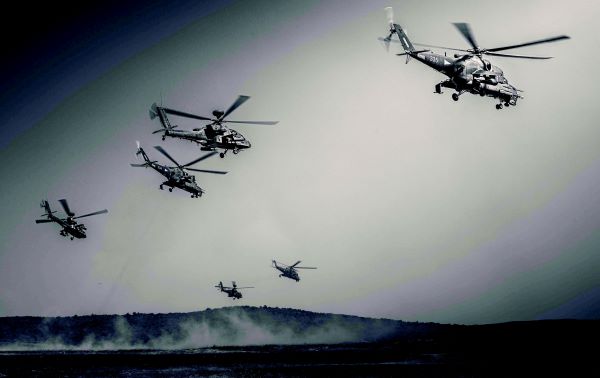
Branch Chief’s Corner / By MG David J. Francis: Army Aviation continues to demonstrate to our nation the resilience and inherent flexibility we possess across our branch.
This past year was one of shared challenges and significant progress with an unprecedented unity of effort across the Army Aviation enterprise. Our aviation leaders across all three components kept the momentum through the challenges of the COVID-19 pandemic, natural disasters, unprecedented social unrest, and the demands around the world for aviation capabilities. Throughout this tumultuous year, we implemented initiatives that will prepare our aviators for Large Scale Combat Operations (LSCO). Given the pace of Army modernization and the rapid improvement of our competitors’ capabilities, we must maintain the momentum that continues to make Aviation an asymmetric capability for our Army.

Army AH-64 Apaches fly in formation with Hungarian Mi-24 Hinds during Saber Guardian in Varpalota, Hungary, June 9, 2021. The multi-national exercise aims to increase participating nations’ capacity to conduct full spectrum military operations.
Adapting How We Fight
To be an MDO capable force by 2028, Army Aviation must change now. The aggressive modernization of our equipment is ongoing and necessary, but only one part of the change. We must also change our Doctrine, Organization, Training, and Leader Development.
Adapting how we fight includes updating our concepts, doctrine, organizaions, and the training that prepares us for LSCO. We are sharing all of the emerging doctrine and training techniques through collaborative forums like the Aviation Warfighting Forum and the Aviation Senior Leader Course. We leverage these opportunities to communicate training methodologies and other aviation issues as we prepare these formations to compete and win in LSCO. Training Support Packages have proven instrumental in shaping training from the team to the company levels, preparing units for the lower flight profiles and tactics required for an environment with integrated air defense systems (IADS). Combat training centers (CTCs) are challenging our aviation units to conduct combined arms maneuver in a Denied, Degraded, and Disrupted, Space Operational Environment (D3SOE). Understanding how we will fight as a maneuver force drives our individual and collective training.
We understand the Army requires enduring fleets and Future Vertical Lift (FVL) platforms with next-generation tactical UAS enabling the combined arms team to dominate peer and near-peer adversaries. Our momentum has our Future Vertical Lift on track with extensive testing of enabling systems through venues like Edge 21 and Project Convergence 21. Our Senior leadership understands that we cannot afford to slow our modernization efforts. Modernizing ensures Army Aviation has wellled, well-equipped, and well-trained Soldiers, organized into effective warfighting formations with sufficient capacity to win in any conflict, on any battlefield, anywhere in the world.
Initiatives
Beyond the material development, we know our Soldiers and Aviators have to be tactically and technically proficient. We are the most flexible and lethal capability for the ground force com-manders and must have an advanced understanding of warfighting. This summer we are running the first Advanced Warfighting Skills (AWS) pilot course designed to provide our junior CW2 aviation professionals an immersion in tactics and employment of aviation rel-evant to ground forces in a Large Scale Combat Operations environment. Over 90% of our aviation force received and implemented the Emergency Response Methodology (ERM) and the Flight Reference Cards (FRCs). The success of this initiative is directly tied to the lead-ership and discipline throughout our aviation formations and is another key to maintain the momentum to transform the way our aviators handle emergency procedures, improving our readiness and protecting our force. The Unit Trainer/Evaluator (UTE) program is rapidly taking shape with two combat aviation brigades (CABs) completing their initial qualifications with assistance from DES. By the 1st QTR FY 22, we will have three CABs complete with UT/E and a plan to jump start five total CABs by the end of the calendar year. The suc-cess of this initiative is directly tied to our senior warrant officers embracing the concept and nominating the best candidates for the program. We have been able to transcend these challenges and implement leader development ini-tiatives because our leaders continue to apply the energy, leadership, and direc-tion to prepare our leaders for 2028 and beyond. This momentum to continually sharpen our tactical skills is who we are as a branch in support of our Army.
We must transform today to meet tomorrow’s challenges. The momentum we have must be continued as we adapt and modernize our training, systems, and doctrine across the entire enterprise. The key is to commit to this transformation and continue to coordi-nate throughout the branch to ensure our initiatives and transformative efforts are realized throughout the institutional and operational Army. As always, I remain proud to be a part of this great branch with professionals that are de-voted in preparing Army Aviation for the future challenges.
Above the Best!
MG David J. Francis is the Army Aviation branch chief and commander of the U.S. Army Aviation Center of Excellence and Fort Rucker, AL.








